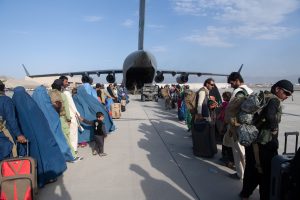When Afghanistan fell to the Taliban, thousands of American military veterans like us felt a moral call to service. Thousands of miles away, we put our lives on hold in a mad scramble to help get our Afghan allies to safety. We filled out visa applications and flight manifests. We guided Afghans around Taliban checkpoints using satellite imagery. We created secret codewords and images to be presented to American troops at the airport. We even figured out landing rights for charter aircraft for third countries. We did everything we could, calling in every favor.
But while our efforts achieved some success, our mission isn’t over. As many as 265,000 of our Afghan allies have been left behind in Afghanistan since the U.S. withdrawal. They are vulnerable to being targeted by the repressive Taliban. Reports of executions and kidnappings have already surfaced. Our abandonment of these Afghans is a moral failure that leaves a stain on our nation.
Far too many Afghans remain in the clutches of the Taliban, which is reverting to its barbaric roots. The pending economic collapse and food shortages within Afghanistan could leave 1 million children dead. After our chaotic exit from Afghanistan, the U.S. government must implement a clear whole-of-government strategy to stand up for Afghan human rights by evacuating vulnerable Afghans. The Biden administration must mobilize resources from across the government to take the following steps:
First, Special Immigrant Visa (SIV) applications must be more expeditiously processed. According to our sources, the State Department expects the current backlog to take six to nine months to process. While U.S. government personnel have been honorably working long hours, additional temporary billets must be created to allow properly-cleared civil servants from across the government to help expedite visa processing.
Second, the U.S. government must be transparent about what it plans to do to support our allies trapped in Afghanistan. The State Department must create a centralized information hub in Dari, Pashto, and English that provides specific instructions and contact information for the Afghans left behind. The current paucity of details leaves Afghans vulnerable to fraud, misinformation, and targeting by nefarious actors. Multiple lines of communication into the State Department and Department of Defense slow down the evacuation process. Afghans are resorting to the use of smugglers, possibly opening up themselves to exploitation. A more robust communication effort will also help gain public support from the American public.
Third, the State Department must partner more effectively with countries bordering Afghanistan to provide refuge and safe passage for Afghans. There is no systematic process for seeking safety in any of Afghanistan’s neighbors. Afghans we’ve spoken to say bribery has sometimes worked, but the vast majority of Afghan refugees are turned away near the borders, forced into a life on the run from the Taliban. The U.S. must help Afghanistan’s neighbors defray the financial costs of sheltering these refugees, similar to how the EU supported Turkey with the inflow of Syrian refugees.
Fourth, the U.S. government must make it easier for private American citizens to assist in helping Afghans get to safety. Non-profit coalitions like Welcome.US are helping to centralize the range of siloed efforts. However, the thousands of volunteers like us across the United States deserve more clear guidance from our government. Related to the effort to get private citizens more involved, the U.S. Citizenship and Immigration Services must eliminate the $575 humanitarian parole application fee. Reducing this barrier will help save lives.
Finally, the State Department must determine a method for Afghans to be issued new travel documents, including passports. The U.S. embassy in Kabul destroyed the Afghan passports in its possession as Kabul fell, along with other critical and sensitive documents. New travel documents are critical for U.S. Refugee Admissions Program (P1 and P2) applicants, who must be outside of Afghanistan before their visa applications will be processed.
These steps are just the beginning. Once these Afghans reach safety, the process of settling into the United States and other host countries will be a long, arduous journey. Some in the U.S. have argued that we should not take in so many Afghans, fearing an increase in crime and pointing to anti-immigrant protests in Europe. We must welcome these Afghans into our country with open hearts. While the U.S. devoted far too little to getting Afghans out before the Taliban takeover, it’s not too late for our government to act to save the many thousands still left behind.

































